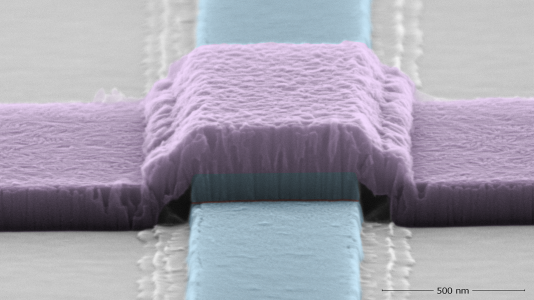Josephson Junction
Superconducting qubits are fundamentally based on the Josephson Junction. A Josephson Junction is a sandwich-like structure consisting of two superconductors separated by a non-superconducting material. Due to quantum tunneling, superconducting current can pass through the non-superconducting layer. Commonly used materials are aluminum-based (Al) or niobium-based (Nb). A Josephson Junction can be fabricated by first depositing a superconducting metal layer on a substrate, allowing it to oxidize and form a thin insulating oxide layer (the non-superconducting layer), and then depositing another superconducting metal layer. This Superconductor-Insulator-Superconductor structure is known as an SIS junction.
▲ (a) Schematic of an SIS Josephson Junction. (b) Electron microscope image of an aluminum-based SIS junction. (c) The superconducting critical temperature \(T_c = 1.2K\) for aluminum, while niobium has the highest \(T_c = 9.2K\) among single-element superconductors. Therefore, using niobium can provide better stability for qubits. However, the structural difference between niobium oxide (\(Nb_2O_5\)) and metallic niobium makes it difficult to produce high-performance Josephson Junctions. Hence, a multilayer structure \(Nb-Re-Al_2O_3-Al-Nb\) is used, where alumina serves as the insulating layer, and thin \(Re\) and \(Al\) layers act as buffer layers. This buffer technique, common in modern semiconductor manufacturing (heterogeneous integration), involves using two or three atomic layers to bridge the mismatch between two materials with different lattice constants. Another well-known quantum effect in quantum materials is the proximity effect, where the wave function of the bulk material fully penetrates the thin film layer, effectively transforming the thin film's properties into those of the bulk material. Due to the proximity effect, the buffer layer also becomes superconducting, making this multilayer structure an SIS junction.
Ref: 10.1557/mrs.2013.229
▲ Example of a niobium-based Josephson Junction
Ref: David Schuster of Stanford University
https://www.anl.gov/article/resurrecting-niobium-for-quantum-science
https://schusterlab.stanford.edu/research.html
▲ Quantum effects are fragile. In fact, Josephson Junctions are highly sensitive, and fabricating a well-insulated layer that is perfectly integrated into the sandwich structure is extremely challenging. Any defects in the structure can lead to qubit decoherence and errors. Therefore, scientists continuously explore alternative solutions. Figure (b) shows a theoretical proposal using constriction, where local superconductivity is lost naturally, forming a Josephson Junction (ScS).
Ref: 10.1103/PhysRevA.110.012427
https://quantumzeitgeist.com/superconducting-qubits-get-boost-with-novel-constriction-design/
Originally written in Chinese by the author, these articles are translated into English to invite cross-language resonance.



 Peir-Ru Wang
Peir-Ru Wang